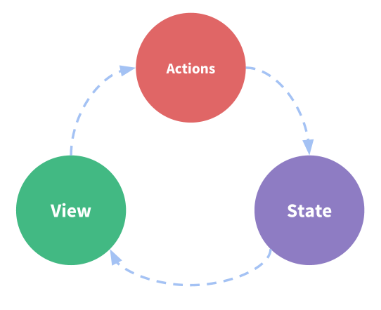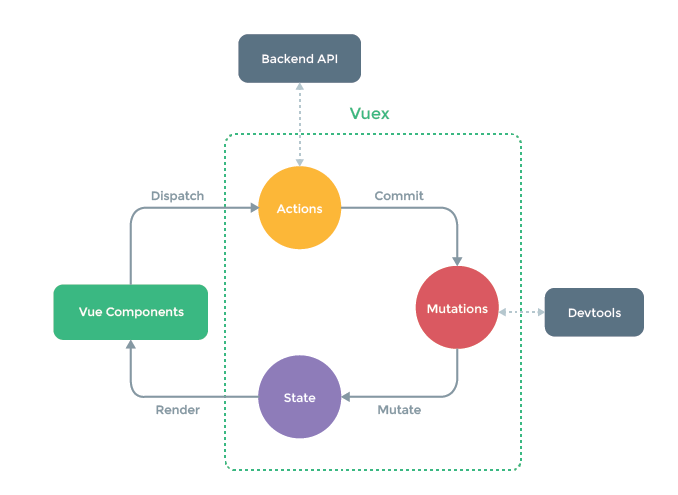通读官方文档和平时使用的总结和注意点
核心概念
核心概念中的例子仅作理解,实际运用参考模块化使用
Vuex 是什么?
Vuex 是一个专为 Vue.js 应用程序开发的状态管理模式。
它采用集中式存储管理应用的所有组件的状态,并以相应的规则保证状态以一种可预测的方式发生变化。
这个状态自管理应用包含以下几个部分:
- state,驱动应用的数据源;
- view,以声明方式将 state 映射到视图;
- actions,响应在 view 上的用户输入导致的状态变化。

store(仓库)
每一个 Vuex 应用的核心就是 store(仓库)。
“store”基本上就是一个容器,它包含着你的应用中大部分的状态 (state)。
Vuex 和单纯的全局对象有以下两点不同:
- Vuex 的状态存储是响应式的。当 Vue 组件从 store 中读取状态的时候,若 store 中的状态发生变化,那么相应的组件也会相应地得到高效更新。
- 你不能直接改变 store 中的状态。改变 store 中的状态的唯一途径就是显式地提交 (commit) mutation。这样使得我们可以方便地跟踪每一个状态的变化,从而让我们能够实现一些工具帮助我们更好地了解我们的应用。
State
下面是一个最简单的store中获取state的示例
通过属性获取
安装 Vuex 之后
1
2
3
4
5
6
7
8
9
10
11
12// 如果在模块化构建系统中,请确保在开头调用了 Vue.use(Vuex)
const store = new Vuex.Store({
state: {
count: 0
},
mutations: {
increment (state) {
state.count++
}
}
})通过
store.state来获取状态对象,以及通过store.commit方法触发状态变更:1
2
3store.commit('increment')
console.log(store.state.count) // -> 1通过在根实例中注册
store选项,该 store 实例会注入到根组件下的所有子组件中,且子组件能通过this.$store访问到。1
2
3
4
5
6
7
8
9
10
11const app = new Vue({
el: '#app',
// 把 store 对象提供给 “store” 选项,这可以把 store 的实例注入所有的子组件
store,
components: { Counter },
template: `
<div class="app">
<counter></counter>
</div>
`
})组件中调用
由于 store 中的状态是响应式的,在组件中调用 store 中的状态简单到仅需要在
计算属性中返回即可。触发变化也仅仅是在组件的methods中提交 mutation。1
2
3
4
5
6
7
8
9// 创建一个 Counter 组件
const Counter = {
template: `<div>{{ count }}</div>`,
computed: {
count () {
return this.$store.state.count
}
}
}
mapState
当一个组件需要获取多个状态时候,将这些状态都声明为计算属性会有些重复和冗余。
为了解决这个问题,我们可以使用 mapState 辅助函数帮助我们生成计算属性,让你少按几次键:
1 | // 引入辅助函数 Vuex.mapState |
当映射的计算属性的名称与 state 的子节点名称相同时,我们也可以直接给 mapState 传一个字符串数组
1 | computed: mapState([ // 现在一般这样获取,特殊情况按上面三种方法 |
Getter
Vuex 允许我们在 store 中定义“getter”(可以认为是 store 的计算属性)。
就像计算属性一样,getter 的返回值会根据它的依赖被缓存起来,且只有当它的依赖值发生了改变才会被重新计算。
Getter 接受 state 作为其 第一个参数:
1 | const store = new Vuex.Store({ |
通过属性访问
Getter 会暴露为 store.getters 对象,你可以以属性的形式访问这些值:
1 | store.getters.doneTodos // -> [{ id: 1, text: '...', done: true }] |
Getter 也可以接受其他 getter 作为 第二个参数:
1 | getters: { |
在组件中使用:
1 | computed: { |
注意,getter 在通过属性访问时是作为 Vue 的响应式系统的一部分缓存其中的。
通过方法访问
也可以通过让 getter 返回一个函数,来实现给 getter 传参。在对 store 里的数组进行查询时非常有用。
1 | getters: { |
注意,getter 在通过方法访问时,每次都会去进行调用,而不会缓存结果。
mapGetters
mapGetters 辅助函数仅仅是将 store 中的 getter 映射到局部计算属性:
1 | import { mapGetters } from 'vuex' |
如果你想将一个 getter 属性另取一个名字,使用对象形式:
1 | mapGetters({ |
Mutation
更改 Vuex 的 store 中的状态的唯一方法是提交 mutation。
Vuex 中的 mutation 非常类似于事件:
每个 mutation 都有一个字符串的 事件类型 (type) 和 一个 回调函数 (handler)。
这个回调函数就是我们实际进行状态更改的地方,并且它会接受 state 作为第一个参数:
1 | const store = new Vuex.Store({ |
你不能直接调用一个 mutation handler。
这个选项更像是事件注册:“当触发一个类型为 increment 的 mutation 时,调用此函数。”
要唤醒一个 mutation handler,你需要以相应的 type 调用 store.commit 方法:
1 | store.commit('increment') |
提交载荷(Payload)
你可以向 store.commit 传入额外的参数,即 mutation 的 载荷(payload):
1 | // ... |
在大多数情况下,载荷应该是一个 对象 ,这样可以包含多个字段并且记录的 mutation 会更易读:
1 | // ... |
对象风格的提交方式
提交 mutation 的另一种方式是直接使用包含 type 属性的对象:
1 | store.commit({ |
当使用对象风格的提交方式,整个对象都作为载荷传给 mutation 函数,因此 handler 保持不变:
1 | mutations: { |
使用常量替代 Mutation 事件类型
使用常量替代 mutation 事件类型在各种 Flux 实现中是很常见的模式。
这样可以使 linter 之类的工具发挥作用,同时把这些常量放在单独的文件中可以让你的代码合作者对整个 app 包含的 mutation 一目了然:
1 | // mutation-types.js |
用不用常量取决于你——在需要多人协作的大型项目中,这会很有帮助。但如果你不喜欢,你完全可以不这样做。
当然也可以直接这样:
1 | mutations: { |
Mutation 必须是同步函数
一条重要的原则就是要记住 mutation 必须是同步函数。为什么?请参考下面的例子:
1 | mutations: { |
现在想象,我们正在 debug 一个 app 并且观察 devtool 中的 mutation 日志。每一条 mutation 被记录,devtools 都需要捕捉到前一状态和后一状态的快照。然而,在上面的例子中 mutation 中的异步函数中的回调让这不可能完成:因为当 mutation 触发的时候,回调函数还没有被调用,devtools 不知道什么时候回调函数实际上被调用——实质上任何在回调函数中进行的状态的改变都是不可追踪的。
在组件中提交 Mutation
- 你可以在组件中使用
this.$store.commit('xxx')提交 mutation- 或者使用
mapMutations辅助函数将组件中的 methods 映射为store.commit调用(需要在根节点注入store)。
1 | import { mapMutations } from 'vuex' |
Action
在 mutation 中混合异步调用会导致你的程序很难调试。
例如,当你调用了两个包含异步回调的 mutation 来改变状态,你怎么知道什么时候回调和哪个先回调呢?这就是为什么我们要区分这两个概念。在 Vuex 中,mutation 都是同步事务:
1 | store.commit('increment') |
为了处理异步操作,引入了action
Action 类似于 mutation,不同在于:
- Action 提交的是 mutation,而不是直接变更状态。
- Action 可以包含任意异步操作。
context 对象
注册一个简单的 action:
1 | const store = new Vuex.Store({ |
Action 函数接受一个与 store 实例具有相同方法和属性 的 context 对象
- 因此你可以调用
context.commit提交一个 mutation - 或者通过
context.state和context.getters来获取 state 和 getters。
实践中,我们会经常用到 ES2015 的 参数解构 来简化代码(特别是我们需要调用 commit 很多次的时候):
1 | actions: { |
分发 Action
Action 通过 store.dispatch 方法触发:
1 | store.dispatch('increment') |
乍一眼看上去感觉多此一举,我们直接分发 mutation 岂不更方便?实际上并非如此,还记得 mutation 必须同步执行这个限制么?Action 就不受约束!我们可以在 action 内部执行异步操作:
1 | actions: { |
Actions 支持同样的 载荷方式和对象方式 进行分发:
1 | // 1.以载荷形式分发 |
来看一个更加实际的购物车示例,涉及到调用异步 API 和分发多重 mutation:
1 | actions: { |
注意我们正在进行一系列的异步操作,并且通过提交 mutation 来记录 action 产生的副作用(即状态变更)。
在组件中分发 Action
- 在组件中使用
this.$store.dispatch('xxx')分发 action - 或者使用
mapActions辅助函数将组件的 methods 映射为store.dispatch调用(需要先在根节点注入store):
1 | import { mapActions } from 'vuex' |
组合 Action
Action 通常是异步的,那么如何知道 action 什么时候结束呢?更重要的是,我们如何才能组合多个 action,以处理更加复杂的异步流程?
首先,你需要明白 store.dispatch 可以处理被触发的 action 的处理函数返回的 Promise,并且 store.dispatch 仍旧返回 Promise:
1 | actions: { |
现在你可以在组件中:
1
2
3store.dispatch('actionA').then(() => {
// ...
})在另外一个 action 中也可以:
1
2
3
4
5
6
7
8actions: {
// ...
actionB ({ dispatch, commit }) {
return dispatch('actionA').then(() => {
commit('someOtherMutation')
})
}
}
最后,如果我们利用 async / await,我们可以如下组合 action:
1 | // 假设 getData() 和 getOtherData() 返回的是 Promise |
一个
store.dispatch在不同模块中可以触发多个 action 函数。在这种情况下,只有当所有触发函数完成后,返回的 Promise 才会执行。
Module
由于使用单一状态树,应用的所有状态会集中到一个比较大的对象。当应用变得非常复杂时,store 对象就有可能变得相当臃肿。
为了解决以上问题,Vuex 允许我们将 store 分割成 模块(module)。每个模块拥有自己的 state、mutation、action、getter、甚至是嵌套子模块——从上至下进行同样方式的分割:
1 | const moduleA = { |
模块的局部状态
对于模块内部的 mutation 和 getter,接收的第一个参数是模块的局部状态对象。
1 | const moduleA = { |
同样,对于模块内部的 action,局部状态通过 context.state 暴露出来,根节点状态则为 context.rootState:
1 | const moduleA = { |
对于模块内部的 getter,根节点状态会作为第三个参数暴露出来:
1 | const moduleA = { |
命名空间
总结
Vuex 交互原理图:

States:数据区,所有共享的状态(数据)可以放在这里
Mutations:改变State的状态(数据)
Actions:通过异步的方式调用Mutations
调用方式:
- States:
store.state.xxx - Mutations:
store.commit('xxx') - Actions:
store.dispatch('xxx') - Getter:
store.getters.xxx
易混淆
mapState和mapGetter
基本用法
main.js 文件
1
2
3
4
5
6
7
8import Vue from 'vue'
import store from './store'
new Vue({
router,
store,
render: h => h(App)
}).$mount('#app')store.js 文件
1
2
3
4
5
6
7
8
9
10
11
12
13
14
15
16
17
18
19
20
21
22
23import Vue from 'vue'
import Vuex from 'vuex'
Vue.use(Vuex)
export default new Vuex.Store({
// 数据区,所有共享的状态(数据)可以放在这里
state: {
test: 1
},
// 改变State的状态(数据)
mutations: {
'SET_TEST': (state, newTest) => {
state.test = newTest
}
},
// 异步调用mutations里的方法
actions: {
setTest: ({ commit, state }, newTest) => {
return commit('SET_TEST', newTest) // return 返回一个promise对象
}
}
})APP.vue 文件
1
2
3
4
5
6
7
8
9
10<script>
export default {
mounted() {
this.$store.dispatch('setTest',150)
.then(() => {
console.log("修改后的数据:" + this.$store.state.test);
})
},
}
</script>
模块化用法(推荐)
结合mixin.js文件使用
参考代码:https://github.com/Cynthia0329/ebook/tree/master/src/store
在store目录下
首先 store文件夹下的modules文件夹中 创建一个 模块文件 book.js
1
2
3
4
5
6
7
8
9
10
11
12
13
14const book = {
state: {
// 这里放自定义的需要公用的变量
fileName: '',
},
mutations: {
// 这里放 改变变量的方法
'SET_FILENAME': (state, fileName) => {
state.fileName = fileName
}
}
}
export default bookstore文件夹下的 actions.js文件:这里异步调用mutations中的方法
1
2
3
4
5
6const actions = {
setFileName: ({ commit }, fileName) => {
return commit('SET_FILENAME', fileName) // return 返回一个promise对象
}
}
export default actionsstore文件夹下的 getter.js文件:得到 公用的变量 的回调函数 对象集合(后续可以直接引用)
1
2
3
4const book = {
fileName: state => state.book.fileName
}
export default bookstore文件夹下的 index.js文件:将上面三个文件联系起来,并导入相应的插件和包
1
2
3
4
5
6
7
8
9
10
11
12
13
14
15
16
17import Vue from 'vue'
import Vuex from 'vuex'
// 导入上面的三个文件
import book from './modules/book.js'
import getters from './getters.js'
import actions from './actions.js'
Vue.use(Vuex)
export default new Vuex.Store({
modules: {
book // 模块文件导出的对象
},
getters, //actions.js文件
actions //getter.js文件
})
在utils目录下
mixins 标签原理:
1 | (property) mixins: { |
utils文件夹下的 mixin.js文件
1
2
3
4
5
6
7
8
9
10
11
12
13
14
15
16import { mapGetters, mapActions } from 'vuex'
export const ebookMixin = {
// 这里调用getter.js中的对象,mapGetters方法结合computed将对象中的回调函数执行成相应的数值
computed: {
...mapGetters([
'fileName',
])
},
// 这里调用actions.js中的方法
methods: {
...mapActions([
'setFileName',
])
}
}
在组件中调用
1 | // 导入 mixin 中组件相应的对象 |